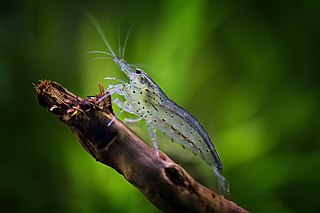
Caridina multidentata is a species of shrimp in the family Atyidae. It is native to Japan and Taiwan. Its common names include Yamato shrimp, Japanese shrimp, Amano shrimp, and algae shrimp.

Caridina is a genus of freshwater atyid shrimp. They are widely found in tropical or subtropical water in Asia, Oceania and Africa. They are filter-feeders and omnivorous scavengers. They range from 0.9–9.8 mm to 1.2–7.4 mm in carapace length.

Takashi Amano was a professional track cyclist, photographer, designer, and aquarist. His interest in aquaria led him to create the Japanese company Aqua Design Amano.
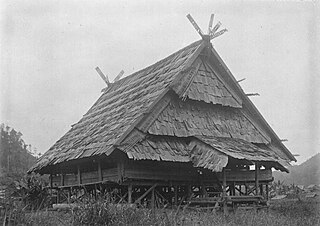
Lake Poso is a lake in Central Sulawesi, Indonesia, and the third-deepest lake in Indonesia.

Lake Towuti is a lake in East Luwu Regency, South Sulawesi province, Indonesia. Surrounded by mountains, it is the largest lake of the island of Sulawesi and one of the five lakes of the Malili Lake system. A river flows from the lake to the Boni Bay. The town Laronda is located on its shore.

Caridina gracilirostris is a species of brackishwater shrimp belong to genus Caridina in the family Atyidae. It has a wide native range extending from Japan and Fiji through Indonesia to Madagascar. It is an algae-eating species that lives in mangroves and marshes. Its common names include red front shrimp, red rhinoceros shrimp, red nosed phantom shrimp, and needlenose caridina, red nosed shrimp.

China, with one-fifth of the world's population, accounts for two-thirds of the world's reported aquaculture production.

Caridina dennerli is a small species of freshwater shrimp from Sulawesi (Indonesia) that grows up to 2.5 centimetres (1.0 in) in length. It takes its name from the German company Dennerle, which supported the expedition that led to the scientific description of the species. It is popularly known as the 'cardinal shrimp' in the aquarium trade.
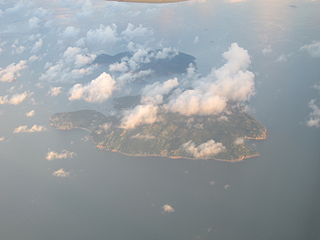
Dawanshan Dao, or Dawanshan Island, is an island in the southwest Wanshan Archipelago, offshore of Zhuhai, Guangdong in China. Xiaowanshan Dao is located in the west of Dawanshan Dao. Dawanshan Dao has an area of 8.1 km2 and a population of about 3,000. The seat of Wanshan Town (万山镇) of Zhuhai is located on the island.

Caridina cantonensis, the bee shrimp, is a species of small freshwater shrimp in the family Atyidae. It is native to Taiwan. These shrimp are scavengers, and eat small pieces of decayed vegetation and algae. Bee shrimp have a life span of about 18 months. They enjoy a temperature in the 70 to 78 °F range. Many modern versions of bee shrimp are selectively bred for their characteristics.

Caridina spongicola is a small species of freshwater shrimp from Sulawesi (Indonesia) that reaches 0.64 to 1.27 cm in length. In the wild it strictly lives on an undescribed species of freshwater sponge, making it one of only two known commensal species of freshwater shrimp. It is popularly known as the harlequin shrimp, and also sometimes Celebes beauty shrimp or sponge shrimp in the aquarium trade. It is often confused with Caridina woltereckae, a larger and more contrastingly colored species found in the same region as C. spongicola.

Caridina woltereckae, or Sulawesi harlequin shrimp as it is commonly known in the aquarium hobby, is a freshwater shrimp from Sulawesi, Indonesia. It is endemic to Lake Towuti. It resembles the smaller and less contrastingly coloured Caridina spongicola, which is endemic to the same lake.
Caridina semiblepsia is a cave dwelling freshwater shrimp from China. It is only known from one location: the Baojing Cave in the province of Hunan.
Caridina apodosis is a species of freshwater shrimp in the family Atyidae endemic to a mountain stream near the village of Tai Tong, China. Caridina apodosis is known from only the type series, collected in 1994. The exact type locality is unknown, and may be completely overtaken by urban sprawl. Caridina apodosis is assessed as Critically Endangered by the IUCN under criterion B1ab(iii)+2ab(iii) with the caveat 'possibly extinct'. C. apodosis is threatened by extensive water pollution as a result of urbanization, and the type locality may be unsuitable for inhabitance.
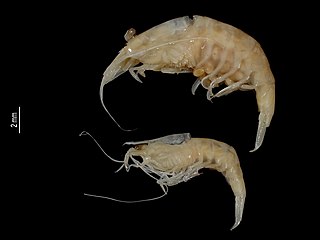
Caridina linduensis is a species of freshwater shrimp in the family Atyidae, endemic to Lake Lindu and its effluent stream in Sulawesi. It was known only from the type series, collected in 1904, and was recorded again in 2011 in a survey around Lake Lindu and is found in shallow littoral habitats of leaf litter, macrophytes, and dead wood. In the effluent stream it is found on soft substrates and slow flowing water, and is less common in the lake itself. The type locality of Lake Lindu was designated as a Recreation Park in 1978, and is part of the larger Lore Lindu National Park and UNESCO Biosphere Reserve. It is listed under IUCN criterion B1ab(iii,v) as Critically Endangered due to threats from introduced species of fish, land conversion to agriculture, logging, and shore disturbance caused by the grazing of water buffalo. Surveys are required to find the full distribution of C. linduensis, primarily its habitat in the effluent stream. C. linduensis is also sympatric with the recently described species Caridina dali and Caridina kaili.

Nanhaipotamon is a genus of freshwater crabs, in the subfamily Potamiscinae, found in southern China and Taiwan. As of 2018, 18 species have been described. The genus is named after the South China Sea, for it occurs mostly in coastal areas. The genus was first described by R. Bott in 1968 as Isolapotamon (Nanhaipotamon), i.e., a subgenus of Isolapotamon.

Caridina typus, also known as the Australian Amano Shrimp, is a species of amphidromous atyid shrimp. It was first described by H. Milne-Edwards in 1837. It has a broad distribution in tropical freshwater habitats in the Indo-West Pacific region, with its western range extending to eastern Africa and its eastern range extending to Polynesia. It is commonly found in rivers and streams in coastal areas or on islands. C. typus is known to play a role in sediment distribution and shredding leaf litter, manipulating the environment using their pereiopods and setaceous chelae. The species is also an important component of the food web, both as scavengers and as prey items, and is considered a keystone species for the stream ecosystems it inhabits. According to Choy and Marshall, the species can be characterized by a "short, dorsally unarmed rostrum, the presence of epipods on the first four pairs of pereiopods, and the presence of an appendix interna on the endopod of the first pleopod of both sexes." It can be kept in captivity by aquarists as pets.

Caridina glaubrechti is species of lacustrine fresh water shrimp endemic to western part of Lake Towuti on the Indonesian island of Sulawesi. It is named in honor of German Zoologist Matthias Glaubrecht.
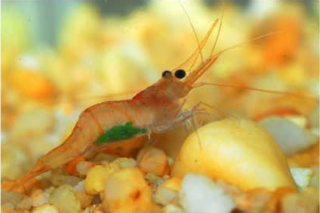
Caridina profundicola is species of fresh water shrimp endemic to Lake Towuti on the Indonesian island of Sulawesi.

















